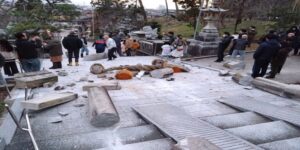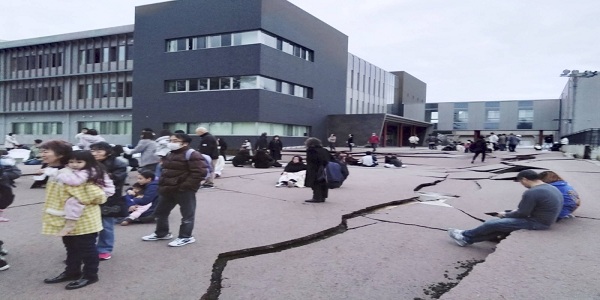Japan was rocked Monday by a powerful earthquake measuring a 7 on Japan’s shindo scale – the strongest rating – prompting tsunami warnings for the length of the country’s western coast.
A major tsunami warning — the highest level of alert — was issued for Ishikawa Prefecture’s Noto Peninsula, with the weather agency warning of waves of up to 5 meters in the area. Other areas of the Sea of Japan coast, from Hokkaido to Nagasaki, were under tsunami warnings or advisories, with waves of up to 3 meters forecast.
Tsunami waves had already arrived in some areas.
The tsunami warning for Ishikawa, Niigata, Toyama and Yamagata prefectures urged people to quickly leave coastal areas, with over 1.2 meter waves reaching the Noto Peninsula’s Wajima Port in Ishikawa at around 4:21 p.m., NHK reported.
People experiencing tsunami of over 1 meter are considered “highly likely to be unable to stand, with possibility of death,” according to the Meteorological Agency.
Since the initial waves hit, the height of tsunami at Wajima Port had been increasing, although the exact measurements had yet to be determined, NHK reported.
The major tsunami warning issued for the Noto Peninsula area was the top-level alert out of three warnings and was equal to one issued after the March 2011 quake in the Tohoku region.
 Speaking to reporters in the evening, Prime Minister Fumio Kishida urged residents of the affected areas to “continue to pay close attention in case of strong earthquakes.”
Speaking to reporters in the evening, Prime Minister Fumio Kishida urged residents of the affected areas to “continue to pay close attention in case of strong earthquakes.”
“And in areas where tsunamis are expected, I would like to request that they evacuate as soon as possible,” he said in Tokyo.
The tsunami warnings were punctuated by several aftershocks across the Noto Peninsula following the largest initial quake, recorded as magnitude 7.6, according to the Meteorological Agency.
Source: Japan Times
Raghda Sawas

